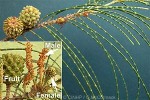Cook Islands Biodiversity Database
Species Page
Casuarina equisetifolia
ToaPacific Ironwood
Multimedia & Additional Resources
| Type | Description | Download |
| Leaves, flowers and fruit (1) | 97KB | |
| Leaves, flowers and fruit (2) | 67KB | |
| Leaves, flowers and fruit (3) | 58KB |
General Information
Cook Islands Distribution
| Southern Group: Present Makatea: Present | ||||||||
RR |
MG |
AT |
MK |
MT |
AK |
PL |
TK |
MN |
++++ |
++++ |
++++ |
++++ |
++++ |
++++ |
P |
++LIR |
|
| Northern Group: Present | |||||
TN |
MH |
RK |
PK |
NS |
SW |
++IR |
P |
+ |
+ |
+ |
- |
Scientific Taxonomy
Casuarina equisetifolia Linnaeus
TAXONOMY: PLANTAE; ANTHOPHYTA (=Angiospermae); MAGNOLIOPSIDA (=Dicotyledones); HAMAMELIDAE; Casuarinales; CASUARINACEAE
More Information
SIGNIFICANCE NOTES -
POSITIVE SIGNIFICANCE: Medicine, Material (Wood). Comments: MATERIAL: Timber extremely hard, dense, lasts well and is very strong. Splits easily and is therefore not good for carpentry. Some older heartwood approaches ebony in being dark, firm and dense. MEDICINE: juice of inner bark used a mouthwash (RR, Joan Rolls, 6/2000, GM).
NEGATIVE SIGNIFICANCE: Weed - minor
GENERAL NOTE: Name Casuarina is derived from Malay Kasuari, the name for the Cassowary bird, because the drooping foliage resembles the bird's drooping feathers.
This species is one of the few Casuarina that can be propogated from cuttings. This species is abundant in present day pollen samples but absent from pre-Polynesian settlement samples, indicating that it was not native, but was introduced by the Polynesians [Ellison 1994 and Atiu also].
Vouchers & References
Vouchers:
Pukapuka: fieldspecimen, 2/2004, G.McCormack with ID as Casuarina equisetifolia.
References:
p.528 Wagner et al.- Flowering Plants of Hawaii
p.288 Neal - In Gardens of Hawaii
p.232 Hortus 3rd
p.218 Royal Hort. Soc. Index of Garden Plants
p.300 Tropica
p.2/253 A.C.Smith - Flora Vitiensis Nova
p.297 I Cheeseman - Flora of Rarotonga
p.38 Wilder - Flora of Rarotonga
p.405d Whistler - Ethnobotany of the Cook Islands
p.93 McCormack/Kunzle - Rarotonga's Mountain Tracks and Plants
Data Update History (information):
zTX, zB02, zM02, zupM04b
Web Resources
Citation Information
McCormack, Gerald (2007) Cook Islands Biodiversity Database, Version 2007.2. Cook Islands Natural Heritage Trust, Rarotonga. Online at http://cookislands.bishopmuseum.org. ![]()
Please refer to our use policy.

